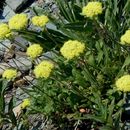fr
noms dans le fil d’Ariane


Variety polyphyllum, as traditionally circumscribed, is an alpine phase of both var. flavum and var. piperi; it is encountered infrequently in scattered range in the high mountains of southwestern Montana and northwestern Wyoming.
Eriogonum flavum is a species of wild buckwheat.
This flower has several common names, including but not limited to: Pipers buckwheat, Pipers golden buckwheat, Yellow umbrella plant,[1] and Pipers Wild Buckwheat.[2]
The species epithet flavum is Latin for yellow and indicates its flower colour.[3][4]
Eriogonum flavum is a perennial herb from taproot and woody caudex that forms dense mats in small areas, with leafless stems approximately 5–20 cm high. The dark green,[1] 2.5–7 cm long leaves are spatulate-oblanceolate with long petioles. The plant is greenish above, while heavily whitish-tomentose below. This perennial herb re-emerges from taproot and woody caudex, and is likely long lived.
Flowers late May to mid July. The inflorescence is a dense umbel (umbrella shaped clusters,[1]) with leaf like bracts at its base. There is one heavily villous involucre, roughly 5–6 mm high per ray of the umbel. The perianth is 4–6 mm long, very hairy, and typically pale yellow. it produces an aroma, that is unpleasant to humans but attracts pollinating bees.[1] Roughly half of the viable population produce flowers in a given season, and seed are uncommon, further supporting longevity. Downhill transport of seeds is primary way of dispersal, but wind probably aids in dispersal uphill. However, downhill growth of caudex branches aids in vegetative dispersal. Fruit are 3–5 mm long three angled achenes that are sparsely pubescent at tip.
"Inflorescences subcapitate or umbellate, 0.5-3(-5) × 0.3-2.5(-3) dm; branches tomentose to floccose; bracts 4-6, leaflike to semileaflike at proximal node, 0.5-2 × 0.2-0.5 cm, sometimes absent immediately below involucre. Involucres 1 per node, turbinate to campanulate, 3-9 × 2-5 mm, tomentose to floccose; teeth 5-8, erect, 0.2-1 mm. Flowers 3-7 mm, including 0.2-1.5 mm stipelike base; perianth pale to bright yellow, densely pubescent abaxially; tepals monomorphic, oblong; stamens exserted, 3-6 mm; filaments pilose proximally. Achenes light brown to brown, 3-5 mm, glabrous except for sparsely pubescent beak."[5]
The plant has been observed as browse for many species of animal, including deer, elk, horses, bighorn sheep and mountain goats which browse the umbels. Blue grouse consume the leaves, as well as insects. Plains tribes of Native Americans used the mashed roots of this plant as ear plugs, and the flowers as an additive for the tanning of buffalo hides. The roots were eaten by children as a sweet snack
There are three subspecies of this species, with subspecies piperi containing two varieties:
This plant is generally found at moderate to high elevation, and grows on rocky open soils to ridges,[1] or grasslands. Grows at 1,000 m in the Yukon, and as low as 170 m in Alaska, although the average throughout the southern portion of its range is around 2133.6 m. Associated with rock, scree, gravel, silt and loamy substrates.[1] Usually associated with southern facing 20o to 50o slopes.
This species of plant has a very extensive range, including most of the Pacific Northwest. It is found north to British Columbia, south to the Blue Mountains of Oregon and California, east to south central Idaho, Colorado, and southwestern Alberta. Subspecies aquilinum is found north to the eastern portions of Alaska and throughout British Columbia and the Yukon.
The noted wildflower author Claude A. Barr regarded yellow umbrella plant as an outstanding garden flower for its green velvety leaves and sulfur yellow flowers. Though it grows on stony soil in barren places in the wild it is successful in ordinary somewhat alkaline soils or even soils high in clay in garden settings. It increases by seed, but the crown and its thick taproot cannot be divided.[6]
Eriogonum flavum is a species of wild buckwheat.
Eriogonum flavum là một loài thực vật có hoa trong họ Rau răm. Loài này được Nutt. ex Benth. mô tả khoa học đầu tiên năm 1837.[1]
Eriogonum flavum là một loài thực vật có hoa trong họ Rau răm. Loài này được Nutt. ex Benth. mô tả khoa học đầu tiên năm 1837.